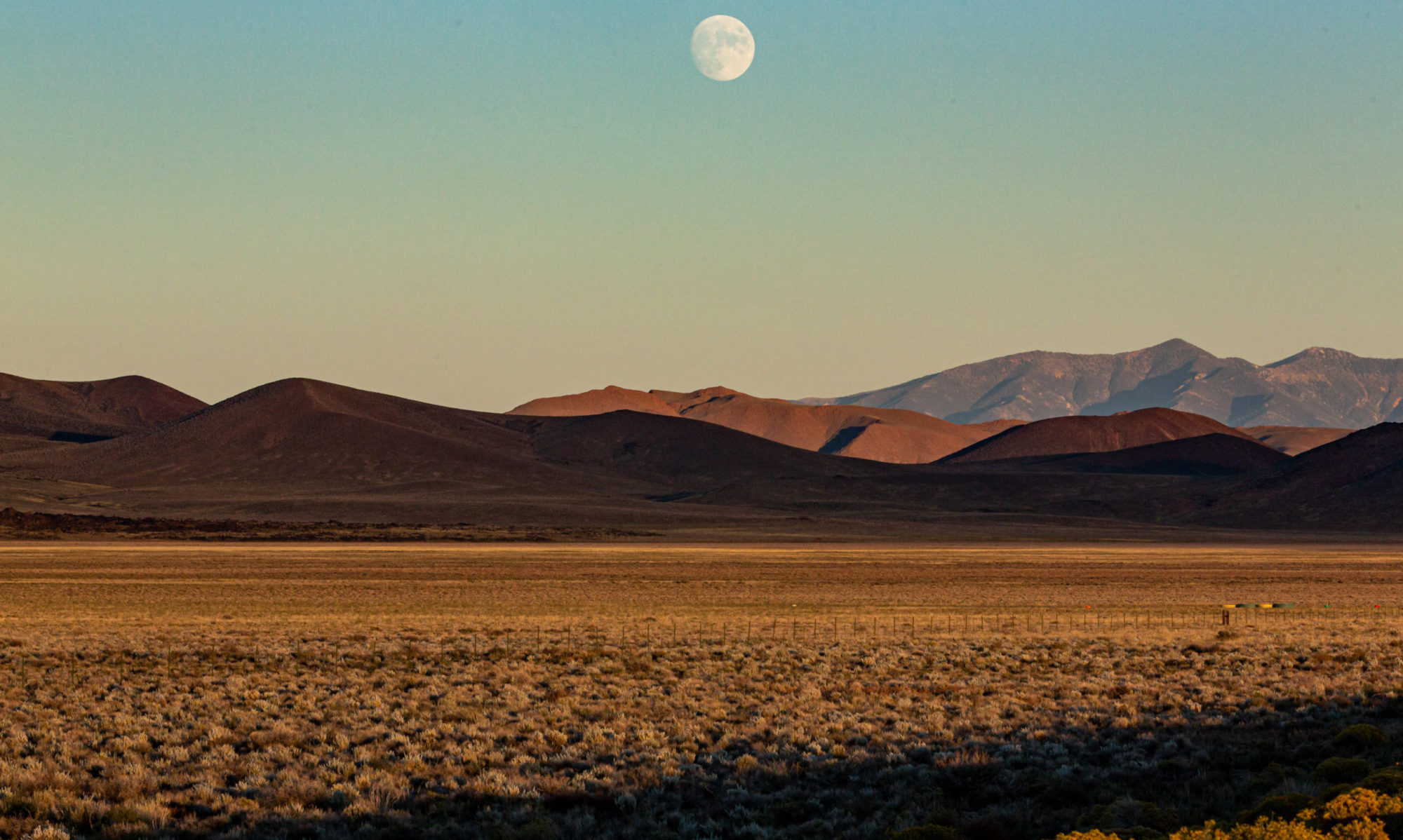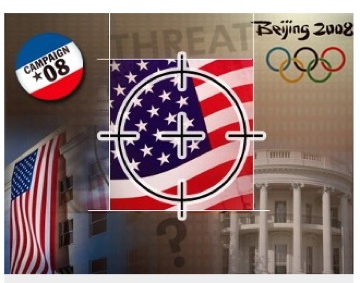
News graphics: they’re hard to beat for their subtlety and artful suggestiveness. This one accompanies a story on the ABC News website: U.S. Headed for ‘Heightened Alert’ Stage. Something about it just makes me feel all warm and fuzzy inside and half expecting to wake up some morning to the news that Dick Cheney has named himself President for Life.
My Walk to Work
Most days, I ride BART from Berkeley to the station at 16th and Mission streets in San Francisco. 16th and Mission is a tough corner in a tough neighborhood. When I was an editorial writer for the San Francisco Examiner in the early ’90s, I wrote a piece about an Irish immigrant who was beaten to death with a baseball bat at an ATM near the corner. That kind of mayhem is rare, I think, but a lower-level kind of chaos, characterized by drug dealing, purse snatching, prostitution, a large population of beggars hanging out, transient hotels, and hairy-looking bars and greasy spoons, is more typical. I’ve been accosted a couple of times in the past six months by women working the street. I spotted one trying to intercept my path one Friday night. She was in high heels, and I sped up to get past her. “Don’t walk so fast!” she shouted. “I’m not going to hurt you!”
For all that, the walk from BART to KQED is still pretty interesting and rarely induces uneasiness for the purposeful walker. In the daylight hours, the biggest hazard is red-light runners and stop-sign jumpers on the major thoroughfares I need to cross–16th, South Van Ness, Folsom, Harrison and Bryant. The walk is about two-thirds of a mile, and I use a route that avoids a vicious block of transient hotels and some very hard-looking dealer types. I wind up on 17th Street. To the west, it rises picturesquely to the Castro and Mount Sutro. Eastward–my direction going to work–it winds up in a knot of streets on the edge of the Mission before crossing a ridge and disappearing into the neighborhood at the northern foot of Potrero Hill. This part of town used to be warehouses and light industry, and today it’s a mix of real and pretend artist lofts, galleries, small theaters, and a few vestiges of the old workshops. Harrison Street, one of the main routes west and south out of downtown, seems to have become what passes for a prominent cycling thoroughfare. I see a few hipster-homesteaders (isn’t it tragic to go by appearances?) riding by every time I’m on the street.
Here are the pictures, to be added to later:
Technorati Tags: san francisco
Two Takes on the Climb
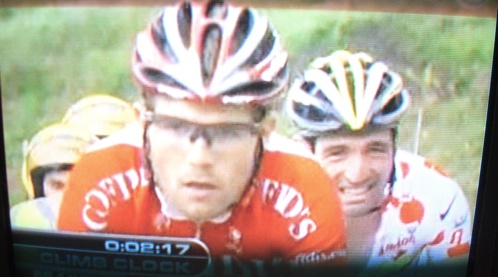
A sort of cheesy Versus screen grab from Tour de France Stage 9, the first Pyrenees day, on July 13. In the foreground: Maxime Monfort of Cofidis. He never showed any expression as he attacked on a tough climb. Behind him: David de la Fuente of Saunier-Duval, who briefly held the polka-dot jersey of the Tour’s leading climber. De la Fuente wore the same dramatic grimace all the way up the hill.
(De la Fuente eventually lost the jersey to teammate Riccardo Ricco, who in turn was ejected from the race after a reported positive test for a form of EPO; which ejection, in turn, caused Saunier, with de la Fuente, to quit the race.)
Technorati Tags: tour de france
Forecast
You’ve got to click on the above to appreciate it (don’t worry–I’m not surreptitiously signing you up for a $10,000 Ukrainian stock brokers conference).
That’s what the next few days look like in Red Bluff, near the head of the Sacramento Valley, 170 road miles from climatically bland Berkeley. I’m not sure of the reasons, but the northern end of the valley is one of the hottest places in the state. During one heat spell in the ’90s, Redding (30 miles north of Red Bluff) hit 117.
The week ahead in Red Bluff: temperatures above 110 for the next three days. And lots of smoke from the fires that won’t go out (and hey, how would you like to be on one of the fire crews trying to put the fires out in that weather?). I’m reading Dante’s Inferno right now. He didn’t know the half of it.
Technorati Tags: california, california wildfires, weather
Greg Lemond on the New Tour
Versus, the jock cable TV network that promotes its Tour de France coverage as part of its “Red, White, Black and Blue Summer” (the network also presents bull riding and some form of fighting in which heavily muscled males punch and kick the crap out of each other), has another mission. With the consensus view now apparently settling on the belief that professional cycling before now was unspeakably shabby and riddled with drug cheaters, Versus is bending over backward to emphasize cycling’s New Really Clean Era.
OK, great. The Tour blew itself apart the last two years by stripping the 2006 champion, Floyd Landis, of his title, and then seeing its 2007 champion in the making, Michael Rasmussen, fired by his team a few days before the end of the race. Unspeakably dirty or not, the Tour was reduced to a shambles and came to represent not only the greatest feats in athletics but the worst of the doping believed to afflict cycling and elite sports in general. However, it’s more than a little disingenuous for Versus, which made built a good audience and raked in good money promoting the legend of Lance Armstrong, to turn around and strike the pose that those days were the bad old days.
As part of its New Clean Era coverage, Versus produced Greg Lemond for an interview on Sunday. Lemond, a great champion in his own right who has made a second career out of trying to undermine Armstrong’s accomplishments, is a spokesman for the Righteous Really Clean New Cycling. Lemond was odd in the interview, a little disjointed and tongue-tied and inarticulate. One of the Versus personalities, Bob Roll, tried to set him up with a question on the new age in the sport: “You have a huge legacy in this race. How do you see the evolution of the sport as it is right now?”
Lemond’s answer:
“I’m more excited about the cycling than I have been in years, and I think there’s a big change, there’s good people in it. Bob Stapleton and Jonathan Vaughters [the men behind the newly sponsored Garmin-Chipotle and Columbia teams] are really making a big effort. I think there’s a desire I’ve never seen before. It’s good. I’m positive.”
Translation: Now that Armstrong and the disgraced Landis have departed the scene, Lemond can get into the sport again. And there are classy people involved, not the scumbags who helped Armstrong eclipse Lemond as America’s greatest racer.
Roll’s cohost, Craig Hummer, asked an interminable question about the meaning of two big name U.S.companies signing on as team sponsors in the last month or so. Lemond seemed to come unhooked from any thread the interview might have had.
“Yeah — you know — cycling is — I’m actually very bullish on just the sport in general. When you look about — look at congestion, you look at the diabetes problem in America, um, it’s probably the best sport to do in terms of low impact but high cardiovascular output. And so I’m really bullish on the sport in general as a leisure activity in America. It is a sport of people past 40, but we need to get those kids in high school, and I’m very optimistic, and the Tour de France, you can’t duplicate this, this is magic, and, uh, I saw it last year, and, I mean, when Rasmussen and Vinokourov, it was quite depressing to my sons, but they still watch cycling, they watched the Tour of Flanders this year. It’s a great sport.”
(Congestion? My co-watcher theorizes he meant asthma.)
Technorati Tags: cycling, floyd landis, greg lemond, lance armstrong, tour de france, versus, vinokourov
Pastime Moment
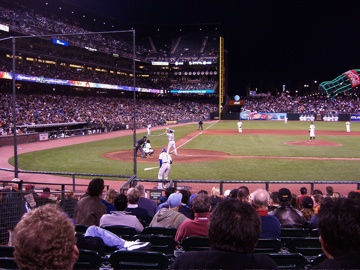
Not a great picture, but here it is just because we were there. Monday, Kate’s old boss called to offer us his pair of very good box seats for that night’s game between the Cubs and Giants. It was a nice evening at Phone Company Park if you were partial to the efforts of the Chicago squad. They won 9-2, and the crowd was sparse enough overall and the proportion of Cubs fans was large enough that you might have mistaken which team was playing at home: every time something went right for Chicago, a loud cheer erupted. The Giants fans concentrated their attention and vocalizing on their starting pitcher, Barry Zito. The latest effort from the $17 million a year lefthander featured five walks and five runs in five innings of work. His record at the end of the night: 3-12. The journalist and sports fan in me feels like there’s a great story to be told about how this guy’s career has imploded.
We didn’t go to the second game of the series last night. The Giants won. No connection implied. (In the picture, that’s the Cubs pitcher Ted Lilly at bat and rightfielder Kosuke Fukudome on deck. Oh, and the seats that provided this view? $71.40 a pop, which makes me marvel at the family of five sitting next to us and grateful for Kate’s boss’s generosity.)
Technorati Tags: baseball, chicago, cubs, chicago cubs
The Rich and Insipid Traveler
Mostly to feed our fantasies, I guess, a few years ago a friend who thought we should travel more sent our names to a travel company called R. Crusoe & Son. Several times a year, we get the R. Crusoe catalogs. Once or twice I’ve perused them seriously–one time they had an off-beat cruise that started in Chicago and went out through the Great Lakes and the St. Lawrence to Newfoundland and then on to Greenland. One of the stops on the tour was L’Anse aux Meadows, the single site in North America where physical evidence has turned up of a Viking settlement. Something about that appealed to me. But we’re talking luxury travel here, inviting people to drop five or maybe even six figures on a trip. When the time comes, I’ll get to Newfoundland for a lot less than that.
Sometime in the last few days, we got the latest R. Crusoe catalog. In format, in style, and substance, they look and read like J. Peterman gone into the travel business. Mostly the results are innocuous. A description of an upcoming trip through China includes these highlights: “Enroll in Shaanxi Normal University for a morning discussion with students. Hear their hopes for the future. … Don’t blush when we view the lesser-known Han Dynasty naked warriors. Emperor Jingdi died in 141 B.C., but he left behind earthenware figurines dressed in silk. The clothing didn’t survive, but the troops are exquisite au naturel.” (Italics Crusoe’s, throughout.)
One of the trips in the brochure goes through Southeast Asia. Vietnam, Cambodia, and other places we Americans have left our mark. The pamphlet acknowledges that we’ve got some history in that part of the world, and the tour will visit war sites. But the past is acknowledged in a bland, chatty, empty — insipid — way that makes you wonder whether the purpose of visiting the region is to remember what happened there or forget about it. Here’s the bulk of the description, which I swear is presented in context:
Begin in Hanoi, which blasts any old associations of the Vietnam War. The 21st century city is a rich stew of influences–Asian and French colonial brand-new and Old Quarter. Our investigation goes forward as it should, by the leisurely pace of a rickshaw.
To Ho Chi Minh’s old haunts. Then poke around in the past with a researcher at the Museum of Ethnology. … See the Hanoi Hilton, where downed American pilots spent more time than they would have liked. …
Emperor Gia Long founded Hue as his dynasty’s first capital. He even created his very own Forbidden City, part of the imperial citadel. Have a look before retooling your sense of romance at dusk aboard a private sampan on the Perfume River. Also here: seven tombs for seven emperors. …
Once Saigon, Ho Chi Minh City sizzles. Its War Remnants Museum presents us with an eye-opening version of the “American War.” Passing the U.S. Consulate, experience a flood of memories–the chopper on the roof evacuating the last Americans.
Over cocktails and dinner, an economics professor brings us up to speed on Vietnam.
Burrow underground in the Cu Chi Tunnels, the very ones that helped change Southeast Asian history for good.
Then Cambodia. Somerset Maugham arrived in 1930 on a languid journey. Jackie O dropped by, too. Like them, we see the country’s light and dark sides.
Touch down in Phnom Penh to dabble in local history at the Royal Palace and its Silver Pagoda (featured in Architectural Digest). Treasures collected from across Cambodia await in the National Museum.Cruise the poetic Mekong River at sunset on a private boat.
Those who want a deeper understanding of the unspeakable horror of the Khmer Rouge can take an option drive to the Killing Fields and visit Tuol Sleng Prison.
Consider today’s Cambodia over lunch with a journalist at the Foreign Correspondents’ Club. …
Our trip winds down with some options: Enjoy a cruise on Southeast Asia’s largest lake, with a stop to see creations of artists disabled by exploded land mines. Instead, head for the finely-carved temple of Banteay Srei. Or get a view of Angkor on a helicopter ride over the complex. …”
That last “instead” is a stunner. It’s as if the person writing the copy suddenly thought, “Amputees?! Get me out of here, Mr. Wizard!” For eight thousand or ten thousand bucks, depending on whether you’re sharing a room on this 17-day extravaganza, a quick extraction from reality is the least you ought to be able expect.
Technorati Tags: travel
More Smoke
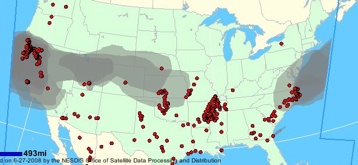
Around the Bay tonight–my part of the Bay, anyway, San Francisco, Berkeley and environs–it looks like we’ve gotten a little break from the smoke. It was cloudy at dusk, and you could actually tell there were clouds in the sky instead of it being a big flat mass of gauze. Out in the Central Valley, and particularly north, in the Sacramento Valley, the smoke is a real issue. The air is so full of particulates–fine, fine ash ejected from the fires burning in every direction–that it’s rated “very unhealthful” to “hazardous” to breathe (for anyone, not just people who have higher health risks because of heart and lung conditions). Hospitals and medical equipment suppliers gave away as many as 2,400 respirator masks in Redding and Chico. The number of fires said to be burning in California tonight: abour 1,200. The National Weather Service says that the mountains in Northern California may have another spate of dry lightning storms over the weekend.
But California being California, we like to share. The image above (click for larger version) is from the National Oceanic and Atmospheric Administration’s Fire Detection Program page. The red dots are hot spots detected by NOAA satellites. The gray areas are smoke plumes. Here’s a snippet of the text that goes with the image:
California:
Several large wildfires and numerous smaller wildfires in northern
California continue to emit large amounts of moderately dense to dense
smoke which covers much of California, north of 35N, and extends to the
west over the Pacific Ocean.Central US:
Light smoke remnant from the California fires … can
be seen extending across much of the central United States. States over
which the light smoke can be seen include: central Nevada, northern
Utah, southern Wyoming, northern Colorado, southern Nebraska, most of
Kansas and western Missouri.
Technorati Tags: california, california wildfires, fire
The Smoke of Ought-Eight
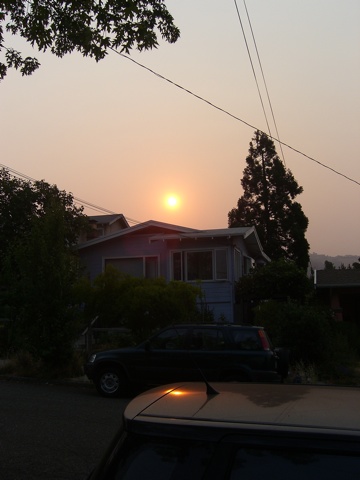
Firefighting agencies say there are over 1,000 wildfires burning in California right now. About 800 of them started last Saturday and Sunday as dry thunderstorms swept over the northern two-thirds of the state. We’re a long way from any fires here. There’s a big one burning about 125 miles north of us, near Clear Lake, and two very large blazes in the mountains that rise up from the Big Sur coast–maybe 150 miles south-southwest of here. Still, the smoke is everywhere. Morning, noon, and evening, the sun shines with a filtered light, and the acrid smell of scorched brush hangs in the air. The picture above is out in front of our house at 7 a.m., after the sun had been up nearly two hours. I’ve been here long enough that I can spin graybeard yarns, but still it’s true: There’s been nothing quite like this here–this pall of smoke that just hangs here day after day–in the 30-some years I’ve lived here.
Technorati Tags: berkeley, california, california wildfires, fire
California Fires
Just briefly: I flew home from Portland today. As soon as we crossed into California, smoke became visible from the scores or hundreds of fires ignited by lightning over the weekend. I managed to roughly match three images I took from my flight to three satellite images of the same general region shot yesterday by NASA. I’ll try to refine later, but the sight of all the smoke–so much that everything here in the Bay Area reeks of it–was truly stunning.
Technorati Tags: california, fire
